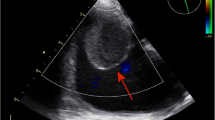Abstract
The study’s objective was to evaluate the applicability of different endovascular methods for treatment of refractory type of Budd–Chiari syndrome (BCS) under specific scenarios frequently encountered in patients. The treatment methods were evaluated in 197 patients with the following four types of refractory BCS: lesions of the inferior vena cava (IVC) including a special shape diaphragm (e.g., a knife- or a vertically shaped diaphragm, etc.), occlusion of the long segment of IVC, IVC obstruction combined with thrombosis, and occlusion of the hepatic vein. The choice of endovascular treatment depended on the degree of difficulty to puncture the membrane after spatial orientation. There was a need to adjust the curvature of the device to fit the natural angle of IVC. When IVC lesions were combined with thrombosis, the treatment was adjusted depending on the freshness of the thrombus. Different routes were used to rupture the membrane and expand the lesion. The majority of patients recovered without complications. The few complications observed were the following: 1 case of death due to a postoperative stress ulcer, 1 case of a successfully treated pericardial tamponade, 1 case of stent migration, and 3 cases of failure to stent and re-occlusion that occurred in the follow-up period. To conclude, BCS is preferably treated via endovascular intervention; however, the particular choice depends on individual circumstances.





Similar content being viewed by others
References
Wang, Z. G., Zhang, F. J., Yi, M. Q., & Qiang, L. X. (2005). Evolution of management for Budd–Chiari syndrome: A team’s view from 2564 patients. ANZ Journal of Surgery, 75, 55–63.
Darwish, M. S., Plessier, A., Hernandez-Guerra, M., Fabris, F., Eapen, C. E., Bahr, M. J., et al. (2009). Etiology, management, and outcome of the Budd–Chiari syndrome. Annals of Internal Medicine, 151, 167–175.
Kohli, V., Pande, G. K., Dev, V., Reddy, K. S., Kaul, U., & Nundy, S. (1993). Management of hepatic venous outflow obstruction. Lancet, 342, 718–722.
Panagiotou, I., Kelekis, D. A., Karatza, C., Nikolaou, V., Mouyia, V., & Brountzos, E. N. (2007). Treatment of Budd–Chiari syndrome by transjugular intrahepatic portosystemic shunt. Hepato-Gastroenterology, 54, 1813–1816.
Xiaoming, Z., & Zhonggao, W. (2003). Interventional or semi-interventional treatment for Budd–Chiari syndrome. Chinese Medical Sciences Journal, 18, 111–115.
Xu, K., Feng, B., Zhong, H., Zhang, X., Su, H., Li, H., et al. (2003). Clinical application of interventional techniques in the treatment of Budd–Chiari syndrome. Chinese Medical Journal (England), 116, 609–615.
Slakey, D. P., Klein, A. S., Venbrux, A. C., & Cameron, J. L. (2001). Budd–Chiari syndrome: Current management options. Annals of Surgery, 233, 522–527.
Srinivasan, P., Rela, M., Prachalias, A., Muiesan, P., Portmann, B., Mufti, G. J., et al. (2002). Liver transplantation for Budd–Chiari syndrome. Transplantation, 73, 973–977.
Xue, H., Li, Y. C., Shakya, P., Palikhe, M., & Jha, R. K. (2010). The role of intravascular intervention in the management of Budd–Chiari syndrome. Digestive Diseases and Sciences, 55, 2659–2663.
Beckett, D., & Olliff, S. (2008). Interventional radiology in the management of Budd Chiari syndrome. Cardiovascular and Interventional Radiology, 31, 839–847.
He, X. H., Li, W. T., Peng, W. J., Li, Y. D., & Tan, H. Q. (2010). Anticoagulation with warfarin for Budd–Chiari syndrome with chronic inferior vena cava thrombosis: An initial clinical experience. Annals of Vascular Surgery, 25(3), 359–365.
Li, T., Zhang, W. W., Bai, W., Zhai, S., & Pang, Z. (2010). Warfarin anticoagulation before angioplasty relieves thrombus burden in Budd–Chiari syndrome caused by inferior vena cava anatomic obstruction. Journal of Vascular Surgery, 52, 1242–1245.
Author information
Authors and Affiliations
Corresponding author
Rights and permissions
About this article
Cite this article
Gao, Y., Chen, S. & Yu, C. Applicability of Different Endovascular Methods for Treatment of Refractory Budd–Chiari Syndrome. Cell Biochem Biophys 61, 453–460 (2011). https://doi.org/10.1007/s12013-011-9211-7
Published:
Issue Date:
DOI: https://doi.org/10.1007/s12013-011-9211-7




